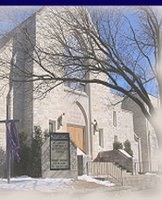 About two months after my visit to the Frank Lloyd Wright church, I began working part-time for an inner-city Lutheran parish. I saw first-hand the seamiest side of the city and learned to move with some ease within it. Working for an avowed liberal pastor, I also saw the soft under-belly of Lutheranism. Six months later, I took my first teaching position at an inner-city Lutheran elementary school. It took me three months to figure out what the principle, the other teachers and my wife already knew—that I did not want to spend the rest of my life grading spelling books; and that I truly loved to study and talk theology.
About two months after my visit to the Frank Lloyd Wright church, I began working part-time for an inner-city Lutheran parish. I saw first-hand the seamiest side of the city and learned to move with some ease within it. Working for an avowed liberal pastor, I also saw the soft under-belly of Lutheranism. Six months later, I took my first teaching position at an inner-city Lutheran elementary school. It took me three months to figure out what the principle, the other teachers and my wife already knew—that I did not want to spend the rest of my life grading spelling books; and that I truly loved to study and talk theology. During that time, I read little about Orthodoxy and we had no icons. But I did begin to use an Eastern Orthodox prayer-book in my private prayers; and, from time to time, I would go to Saturday Vespers at a local OCA parish. (They spoke English, you see.) At the same time (and paradoxically as I think about it), while I learned to understand and didn’t mind the Byzantine rite, my desire and fondness for the Western liturgy grew. In fact, it was the liturgy—not the idea of liturgy, but the historic Western rite—that drew me more into the Faith, and caused me to fall more in love with God. I also began two habits that, by God’s grace, I have sustained to this day: fasting and private confession. Both were introduced by my encounter with the Orthodox faith, and both were affirmed by my blue-blood Lutheran grandparents. (May they rest in peace.)
During that time, I read little about Orthodoxy and we had no icons. But I did begin to use an Eastern Orthodox prayer-book in my private prayers; and, from time to time, I would go to Saturday Vespers at a local OCA parish. (They spoke English, you see.) At the same time (and paradoxically as I think about it), while I learned to understand and didn’t mind the Byzantine rite, my desire and fondness for the Western liturgy grew. In fact, it was the liturgy—not the idea of liturgy, but the historic Western rite—that drew me more into the Faith, and caused me to fall more in love with God. I also began two habits that, by God’s grace, I have sustained to this day: fasting and private confession. Both were introduced by my encounter with the Orthodox faith, and both were affirmed by my blue-blood Lutheran grandparents. (May they rest in peace.)My grandmother told me that she never ate anything after supper on Saturdays before receiving Holy Communion. And my grandfather told me that private confession was common
 when he was my age. Then he related to me the still-vivid story of my grandmother’s pastor standing before the congregation and announcing, in thickly-accented English, that since “vie are no longer tcheman, vie shall no longer kneel or cross ourselves or have private confession; and vie von’t schant the liturgy because it doesn’t sound good in English.” And then the American flag was unfurled in the sanctuary. This pastor’s model for “no longer tcherman” was, of course, the local Methodist church. My grandfather told that story with a bit of shame.
when he was my age. Then he related to me the still-vivid story of my grandmother’s pastor standing before the congregation and announcing, in thickly-accented English, that since “vie are no longer tcheman, vie shall no longer kneel or cross ourselves or have private confession; and vie von’t schant the liturgy because it doesn’t sound good in English.” And then the American flag was unfurled in the sanctuary. This pastor’s model for “no longer tcherman” was, of course, the local Methodist church. My grandfather told that story with a bit of shame.
2 comments:
What's the connection of the picture of the interior sanctuary with your journey, John? Its a strange set up, with the altar on one side, and the huge cross (not Crucifix).
David,
Consider the placement of the picture with the paragraph. It's what happened when LCMS pastors collectively declared "vie are no longer tcheman." In the 1960s and 1970s particularly, many rural churches were "renovated" from their "German look" to this modern "American" look.
Post a Comment